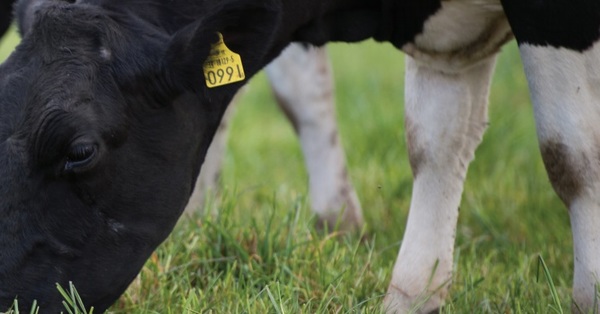
Content sponsored by:
Phileo by Lesaffre
Top tips for turnout to grass
Published: April 19, 2018
Source : Phileo Lessafre

Making the most of grazed grass is critical for any profitable dairy enterprise. When weather conditions allow, farmers will already be trying to get cows out grazing by day and will get their herds out full time as soon as weather and ground conditions, as well as grass supply, allow.
James Ambrose, Technical Manager UK & Ireland for Phileo Lesaffre Animal Care provides some top tips to make the best use of spring grazing…
Gradual turnout
Gradual turnout
Turning cows out to grass creates a big change in diet, as well as imposing a stress event on the cow. It takes around three weeks for the bugs in the rumen to adapt to this, so it is important to manage the transition to grazing gradually, to avoid digestive upsets and loss of performance. Even a few hours of on/off grazing by day, when weather conditions allow, will mean that the rumen bugs can adapt to fresh grass. Cows should be able to consume 5kg DM in approximately 3 hours in suitable swards and weather conditions.
Dry matter intakes
Dry matter intakes
The moisture content of grass can vary significantly in spring, and this can have a major impact on dry matter intakes. At 15% DM a cow estimated to consume 15kg of grass dry matter needs to eat 100kg of fresh grass! It is important that you don’t overestimate the dry matter intake a cow can take from grazing or body condition score, performance and fertility will be compromised.
Excess crude protein
Excess crude protein
Lush, leafy spring grass can often have a crude protein content in excess of 250g/kg DM, particularly after fertiliser application, and this is mainly rumen degradable protein (RDP). Rumen microbes are unable to utilise this much protein from high grass intakes, particularly if there is a shortage of fermentable energy available to them, and so excess RDP is broken down into ammonia in the rumen, and then absorbed into the blood stream and converted to urea in the liver. Elevated blood urea nitrogen levels (BUN) from excessive crude protein in the diet can increase body condition score loss, reduce fertility and impact on hoof health.
Buffer feeding
Buffer feeding
During the transition to grazing when grass is gradually being built up in the diet, it is important to supplement cows with forages with a high energy content and digestibility to maximise dry matter intake. Starch-based forages such as maize silage are a great combination with grass, as the use of nitrogen in the rumen is enhanced and microbial protein synthesis is increased due to the fermentable energy being supplied by the maize starch. High DMD grass silage (>28% DM) is also highly effective. This will help to maintain milk constituents and protein, in particular, as well as ensuring sufficient dry matter intake, which is critical in early lactation.
Highly digestible grass swards can challenge rumen function
Highly digestible grass swards can challenge rumen function
Lush spring grass tends to have a high proportion of leaf to stem, resulting in low structural fibre levels in the overall diet. This lack of ‘scratch factor’ can impact on cudding rates and saliva production, further compromising rumen function. While the nutrient analysis of grass can vary wildly, this lack of structural fibre can be accompanied by high sugar levels – often more than 18% during sunny, dry weather. High sugar levels are great for rumen fermentation, promoting good milk proteins and strong yield, but when supplied in excess in combination with low structural fibre they can challenge rumen function, leading to acute or subacute rumen acidosis (SARA). Consequently, butterfat % and milk protein % can be compromised as a result of the change in rumen fermentation, whilst prolonged challenges can impact on fertility. High levels of unsaturated fatty acids in spring grass can also cause butterfat % to be reduced, so lower butterfat doesn’t always mean SARA is a problem, however.
It is important that compound feed, fed through the parlour, tops up the dry matter that grass and forages do not supply in order to match the energy requirements for a given yield. It is also important that the nutrient content of the compound feed balances that of the grass to optimise rumen fermentation and maximise performance. Aim for a feed that has around 14-16% crude protein, a high digestible fibre content (such as sugar beet pulp and soya hulls), a balanced source of cereals including maize and barley and a source of bypass protein. It should also contain minerals that grass is deficient in, for example magnesium.
Compound feeding
Compound feeding
It is important that compound feed, fed through the parlour, tops up the dry matter that grass and forages do not supply in order to match the energy requirements for a given yield. It is also important that the nutrient content of the compound feed balances that of the grass to optimise rumen fermentation and maximise performance. Aim for a feed that has around 14-16% crude protein, a high digestible fibre content (such as sugar beet pulp and soya hulls), a balanced source of cereals including maize and barley and a source of bypass protein. It should also contain minerals that grass is deficient in, for example magnesium.
Monitor what the cows are telling you
Assess rumen fill 2-3 hours after milking to determine whether adequate grass has been allocated; monitor cudding rate – you are looking for more than 65% of the herd to be lying down chewing the cud 2-3 hours after milking; check dung consistency – loose, bubbly dung with undigested fibre in it is indicative of poor rumen function, as is the presence of cud balls in collecting yards or cubicles; monitor condition – cows losing excessive body condition can point to insufficient feed intake, a possible metabolic disorder, health issue or sub-optimal rumen function.
Milk quality
Monitor bulk tank milk collections for average yields and constituents. A fall in butterfat or protein of 0.3% or greater in one week is a warning sign for poor rumen function and the occurrence of SARA. It is also useful to keep an eye on the butterfat to protein ratio to ensure this falls within the optimum range of circa 1.2:1.
Feed Actisaf Live Yeast
Adding Actisaf live yeast to your cows’ ration will reduce setbacks in performance at turnout by helping the rumen bugs adjust to grazed grass faster and more effectively, thereby improving rumen function. Actisaf also reduces the risk of SARA, both at turnout and throughout the grazing period. Actisaf helps to stabilise rumen function and promotes milk solids and milk yield. It should be included at a recommended rate of 1kg/tonne of grazing compound, assuming a feed rate of 4-8kg compound/cow/day in early lactation.
Source
Phileo LessafreRelated topics:
Recommend
Comment
Share

Would you like to discuss another topic? Create a new post to engage with experts in the community.


